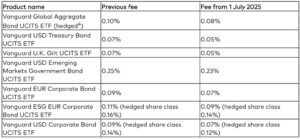“We’re gonna have growth like we’ve never seen before,” says Donald Trump. Growth! Growth! Growth! More jobs! More income! Abundance! Joy, from coast to coast! We know we’re on the road to joy when we see the GDP numbers. They’ll tell us when we are getting what we want – more of everything.
The two parties agree about it. With the advent of the new “abundance” doctrine – the subject of a new book popular with policymakers in the US – growth is the Jehovah now worshipped by the Democrats. The Republicans regard it as their Yahweh too – ever since the virgin birth of “supply-side economics” in the 1970s.
At the same time, the Senate has passed a version of the Big, Beautiful Budget Abomination, with vice-president J.D. Vance casting the tie-breaking vote. The Senate version goes even further into the heart of fiscal darkness than the House version. The numbers are fishy, but it looks like it will add $26 trillion to the nation’s debt by 2035. “Don’t worry about it,” say the Republicans. “Growth will make the debt irrelevant.”
Subscribe to MoneyWeek
Subscribe to MoneyWeek today and get your first six magazine issues absolutely FREE
Get 6 issues free
Sign up to Money Morning
Don’t miss the latest investment and personal finances news, market analysis, plus money-saving tips with our free twice-daily newsletter
Don’t miss the latest investment and personal finances news, market analysis, plus money-saving tips with our free twice-daily newsletter
But although the feds can produce “more” of just about everything – even money – what they can’t produce is real growth. The Soviets showed they could produce as much “growth” as they wanted simply by raising quotas. Factory managers were rewarded or punished based on production targets. A manager might, for example, get a pat on the back depending on the amount of nails turned out, measured in pounds. Easiest for him might be to produce huge, heavy spikes… which no one wanted. In response, the Gosplan geniuses might change the arrangement to give bonuses based on the number of nails, rather than the weight of them. He could then switch to turning out millions of tiny tacks… which, again, no one wanted.
This is the core problem with government projects. We only know if things are worth doing when and if people – of their own free will and with their own real money – pay for them. Otherwise, the transaction is likely to be a scam or a mistake. Ultimately, citizens pay for all of the feds’ bamboozles. But the signal from voters to federal spenders passes through so many lobbyists, grifters and statistical illusions that it loses its information content.
Even if the voters approve of a spending programme, they’re only better off if it produces a real gain. If a hunter expends 2,000 calories catching a rabbit with only 1,500 calories of meat, he is worse off. If he continues in this vein, he will die of starvation. Likewise, an enterprise that applies 100 dollars’ worth of time and resources to provide a service worth only $99 has not only lost money, it’s made the world $1 poorer. On the evidence (and the theory), it is almost impossible for central-planning hacks to keep costs down and produce a real gain for the taxpayers. Even programmes that seem to make sense run over budget and get delayed and distorted.
Thanks to the Fed’s fake interest rates and state and federal regulations, for example, housing prices have roughly doubled in the last ten years, while wages rose only about 50%. This has put the average house out of reach for the average household. Another crisis! What to do about it? More “abundance”, more supply side reforms, more growth, more houses? California’s “affordable-housing” initiatives may cost as much as $1 million per unit. That’s growth! But we will all be a little poorer as a result.
For more from Bill, see bonnerprivateresearch.com
This article was first published in MoneyWeek’s magazine. Enjoy exclusive early access to news, opinion and analysis from our team of financial experts with a MoneyWeek subscription.




